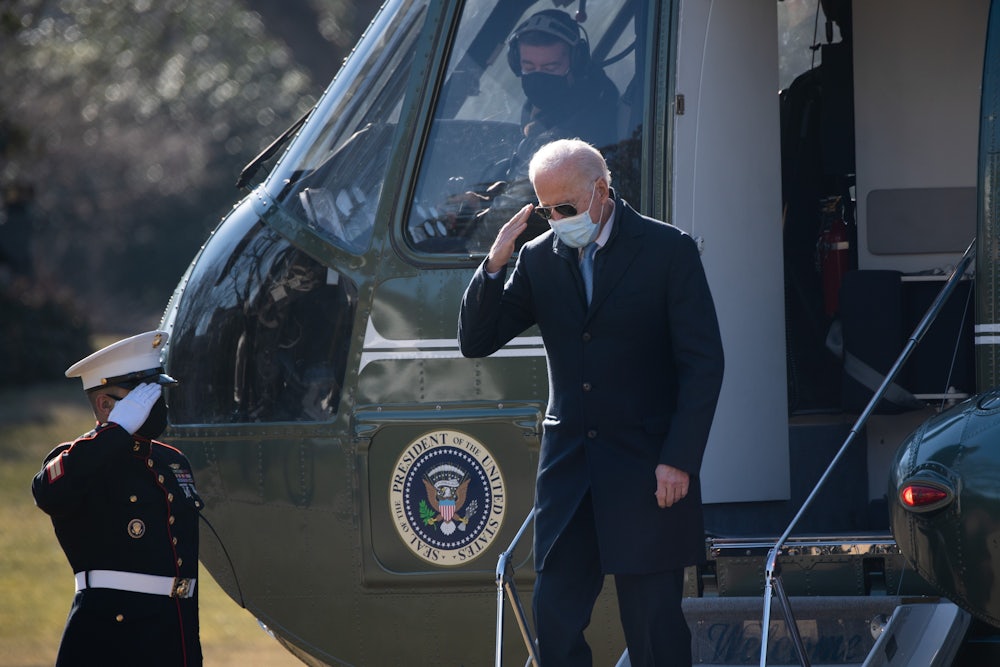“Biden deprioritizes the Middle East,” a Politico headline declared. The president, wrote Natasha Bertrand and Lara Seligman, “is tired of dealing with the Middle East—and, barely a month into his tenure, the region has noticed.”
That was four days ago. On Thursday, in a rite of passage for any American commander in chief, the United States launched an airstrike in eastern Syria that reportedly killed 22 members of an Iranian-sponsored militia that operates in Iraq. The strike was supposedly “defensive”: retaliation for a rocket attack two weeks earlier against an airport in Erbil, Iraq, which killed a Filipino contractor working for the U.S.-led coalition and injured six others.
The strike was defensive in nature, but was a response to the three attacks endangering Americans in Iraq this month, the official said.
— Lara Seligman (@laraseligman) February 26, 2021
Making this situation more complex, U.S. forces are training Iraq’s formal military and counterterrorism units, who fight alongside the very militias the U.S. just bombed. The pretzel logic at work is emblematic of the decades-long quagmire the U.S. has created in the Middle East: We can’t defend one part of our coalition except by bombing another (unacknowledged) portion of it. And with NATO deploying thousands more soldiers to Iraq, and talk of the U.S. altering an agreement with the Taliban to withdraw from Afghanistan by May 1, the American military footprint in the greater Middle East shows no signs of decreasing—just as Biden promised on the campaign trail.
Beltway insiders characterized the latest Syria strike as a strong, measured, and—a favorite descriptor of think tankers and professional hawks—“proportional” deterrent to Iranian aggression, one that will surely lure Iran back to the negotiating table over its nuclear program. It’s not clear how that approach is somehow more persuasive than not bombing Iranian assets (as well as not imposing sanctions on the country, which have strengthened Iranian conservatives and devastated the economy). In fact, it’s not even clear whom the U.S. killed and whether Iran actually supports them: “Little is known about the group, including whether it is backed by Iran or related to the organizations that used the facilities the American air strikes targeted on Thursday. Some American officials contend that the group is merely a front for one of the better-known Shia militias,” The New York Times reported.
Similarly, few seem to care that this strike was a violation of Syrian sovereignty, part and parcel with the ongoing U.S. presence at Al-Tanf, a military base in Syria near the Iraqi border. The airstrikes were ostensibly authorized by the 20-year-old, post-9/11 Authorization for the Use of Military Force, a document that’s become so elastic as to be practically meaningless. To understand what a grim farce this has become, consider a string of tweets by Jen Psaki, Biden’s current spokesperson, less than four years ago. “What is the legal authority for strikes?” she tweeted after Trump fired missiles on Syrian forces. “Assad is a brutal dictator. But Syria is a sovereign country.”
Airstrikes are a constant of the forever war—a perverse form of continuity between presidential administrations of both parties. After spending years ramping up the drone war in several countries, President Barack Obama on his last day in office authorized an airstrike against an Al Qaeda training camp in Syria. More than 100 people died, according to the Defense Department. That last-minute show of force dovetailed smoothly with the beginning of Trump’s administration, which quickly launched a disastrous counterterrorism mission in Yemen that killed at least 35 people, including 8-year-old Nawar Al Awlaki—the third member of the Al Awlaki family, all American citizens, to be killed by U.S. forces in Yemen. On January 19, 2021, the day before Biden assumed the presidency, Africom—the regional command covering U.S. forces in Africa—launched an airstrike against militants in Somalia. Little changed when Biden took office: The conflict-monitoring website Airwars has found evidence of four airstrikes in Somalia in the last month, likely conducted by the CIA or U.S. partners.
The airstrikes are only the most visible expression of American empire. A recent USA Today investigation found that over the last three years, U.S. counterterrorism operations took place in 85 countries. To its credit, the Biden administration announced it would decrease support for Saudi Arabia’s genocidal war in Yemen, which has pushed millions of people to the brink of famine, but we still don’t know exactly what kind of assistance the U.S. will continue to offer Saudi Arabia or whether the ongoing CIA war against Al Qaeda in the Arabian Peninsula—a much-hyped Qaeda affiliate that has never launched a successful attack against the “homeland”—will change in any respect. And there’s still the matter of those 84 other countries.
Some politicians are pushing back against the bipartisan consensus on permanent global warfare. Independent Representative Justin Amash, along with a smattering of Republicans, supported Trump’s efforts—however ham-fisted and politically expedient they were—to withdraw from Afghanistan and Somalia. Democratic Representative Ro Khanna, a leader in challenging the U.S. role in Yemen, said Friday in a statement, “There is absolutely no justification for a president to authorize a military strike that is not in self-defense against an imminent threat without congressional authorization.” Senators Tim Kaine and Chris Murphy, both Democrats, also released statements questioning the strikes. Matt Duss, Bernie Sanders’s foreign policy adviser, who is reportedly up for a position in the State Department, tweeted, “Congress has not authorized war in Syria.”
That has become a sadly tired refrain (see: Psaki, Jen). But it remains as important as ever. In a better world, any use of military force would be controversial, only occurring after deliberation and authorization by Congress. Such a restrained, law-bound approach to warfare might seem anachronistic today, but it’s worth aspiring to. You might even call it “defensive.”








